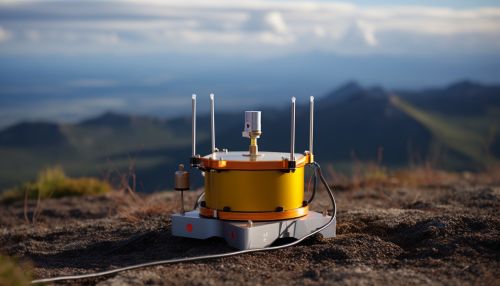Earthquake Early Warning System
Introduction
An Earthquake Early Warning System (EEWS) is a system that detects seismic activity and provides a warning of earthquakes before the destructive seismic waves reach areas that are yet to be affected. The primary goal of an EEWS is to mitigate the damage and loss of life caused by earthquakes by providing people and systems with the time needed to take protective actions.
Principles of Operation
An EEWS operates based on the principle of detecting the initial, less destructive P-waves (primary waves) that travel faster than the more destructive S-waves (secondary waves) and surface waves. The system uses a network of seismometers to detect the P-waves and calculate the earthquake's epicenter and magnitude. Once the P-waves are detected, the system can estimate the arrival time and intensity of the S-waves and surface waves at various locations, allowing for warnings to be issued to those areas.


Components of an EEWS
An EEWS typically consists of three main components: a sensor network, a data processing center, and a dissemination system.
Sensor Network
The sensor network is composed of seismometers strategically placed in areas prone to seismic activity. These sensors detect the initial P-waves generated by an earthquake and transmit this data to the data processing center.
Data Processing Center
The data processing center receives the data from the sensor network and uses algorithms to analyze the data, determine the earthquake's epicenter and magnitude, and predict the arrival time and intensity of the S-waves and surface waves at various locations.
Dissemination System
The dissemination system is responsible for delivering the warnings to the public and other systems. This can be done through various means, such as television and radio broadcasts, mobile phone alerts, and public address systems.
Types of Warnings
There are generally two types of warnings that an EEWS can issue: public warnings and private warnings.
Public Warnings
Public warnings are broadcast to a wide audience, such as an entire city or region. These warnings are typically issued when a significant earthquake is detected that has the potential to cause widespread damage.
Private Warnings
Private warnings are sent to specific users or systems, such as factories, railways, and power plants. These warnings allow these users or systems to take specific actions to mitigate the impact of the earthquake, such as shutting down machinery, slowing down trains, or isolating power grids.
Benefits of an EEWS
An EEWS provides several benefits, including:
- Providing people with time to take protective actions, such as taking cover or evacuating buildings. - Allowing systems to take automated actions to mitigate the impact of the earthquake, such as shutting down gas lines to prevent fires or isolating power grids to prevent blackouts. - Reducing panic by providing accurate and timely information about the earthquake.
Limitations of an EEWS
While an EEWS can provide valuable warnings, it also has several limitations:
- The system can only provide a warning after an earthquake has occurred, and the amount of warning time is limited by the distance from the earthquake's epicenter. - The system may not provide a warning for earthquakes that occur very close to the sensor network, as the P-waves and S-waves will arrive almost simultaneously. - The system's accuracy depends on the quality and coverage of the sensor network and the effectiveness of the data processing algorithms.
See Also
- Seismology - Earthquake Engineering - Disaster Risk Reduction
